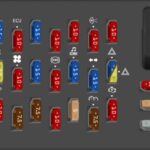The Subaru BRZ, a popular sports coupe known for its nimble handling and responsive engine, utilizes the standard OBD2 port for diagnostics and performance monitoring. Locating this port is crucial for owners who want to understand their car’s health or enhance its performance. This article will guide you to the Brz Obd2 Port location and explain its common uses.
Where is the OBD2 Port on a Subaru BRZ?
The OBD2 port on a Subaru BRZ is typically located under the driver’s side dashboard, near the steering column. It’s often positioned slightly above the footwell area and may be partially obscured by a panel or trim piece. Look for a trapezoidal-shaped connector with 16 pins. You might need to use a flashlight to clearly see the port in the dimly lit area.
Common Uses of the BRZ OBD2 Port
The OBD2 port serves as a gateway to your BRZ’s engine control unit (ECU) and provides access to a wealth of data. Here are some of its most common uses:
-
Diagnostics: Mechanics and car enthusiasts use the port to retrieve Diagnostic Trouble Codes (DTCs), which indicate malfunctions within the vehicle’s systems. This allows for efficient troubleshooting and repair. Code readers and scan tools connect to the OBD2 port to access this information.
-
Performance Monitoring: Aftermarket gauges and performance monitoring devices can be connected to the OBD2 port to display real-time data such as boost pressure, coolant temperature, air/fuel ratio, and more. This is particularly useful for those who want to track their car’s performance on the track or during spirited driving. The P3 gauge, for example, offers advanced features and integrates seamlessly with the BRZ’s OBD2 port. This includes reading boost from OEM sensors.
-
Data Logging: Software applications can log data from the OBD2 port, allowing for in-depth analysis of vehicle performance over time. This data can be used to identify areas for improvement and fine-tune engine parameters.
-
Emissions Testing: State-mandated emissions tests utilize the OBD2 port to verify that the vehicle meets environmental regulations. The port provides access to emissions-related data, ensuring compliance.
-
Custom Tuning: With specialized equipment and software, tuners can access the ECU through the OBD2 port to adjust various engine parameters and optimize performance. This includes modifying fuel maps, ignition timing, and boost levels.
Beyond Diagnostics: Expanding the BRZ’s Capabilities
The BRZ’s OBD2 port offers more than just basic diagnostics. It opens up a world of possibilities for enhancing performance, monitoring vital engine parameters, and customizing the driving experience. Whether you’re a seasoned mechanic or a passionate enthusiast, understanding the location and capabilities of the OBD2 port is essential for unlocking the full potential of your Subaru BRZ. Accessing the port with tools like the P3 gauge opens up access to crucial metrics like engine oil temperature, coolant temperature, and air/fuel ratio. It also allows for code reading and clearing capabilities for DTCs.
